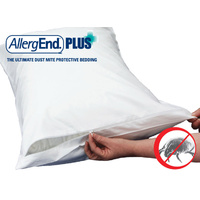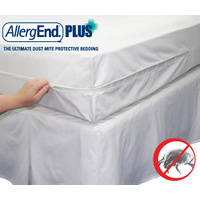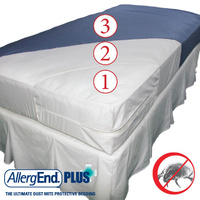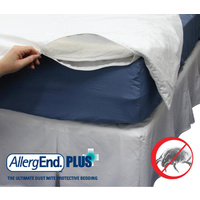How to Control and Manage a Dust Mite Allergy
Care Instructions and Primary Measures
- Encase pillow, mattress and quilt in AllergEnd Plus™ barrier bedding. The great majority of dust mite allergens we are exposed to originate from inside the mattress, pillow and quilt. Click Here to Purchase
- Wash AllergEnd Plus™ mattress, pillow and quilt covers every 8-12 weeks at 60c to kill house dust mites, remove dust mite allergens and dead skin from the outside of the impervious bedding covers.
- Tip. Why not add a "Time to Wash AllergEnd Plus Covers" calender reminder for every 8 weeks so its not forgotten!
- EasyCare System Washing - Wash the EasyCare fitted sheet every 8-12 weeks at 60c and then only wash the full zip up mattress cover every year. Always place your clean bed sheets over the freshly washed AllergEnd Plus Covers.
- Warm tumble drying is an option for normal bed sheets and AllergEnd Plus covers. Some may want to tumble dry on every occasion if pollen allergies are an issue. Line drying can gather pollens at certain times of the year.
- Wash normal bed sheets/linen regularly, at least every week at 60c. Note: Cold washing removes 90% of dust mite allergens as they are water soluble but the dust mite can live through a washing cycle at less than 55c. If the dust mite is not killed in the wash the mite will quickly multiply on the outside of the covers and readily produce more allergens.
- Sufficiently ventilate the dwelling to decrease humidity. Dust mites need a humid environment to survive. A damp, dark house with lots of soft furnishings will provide ideal conditions for house dust mites to live and breed.
Secondary Measures
- Use a high quality vacuum cleaner, i.e. one fitted with a High Efficiency Air Filter (such as a HEPA filter) or an even better option is a ducted vacuum system where the bag/filter are outside and the efficiency of the filter is virtually irrelevant. Vacuuming can actually increase the amount of house dust mite allergen in the air for up to 20 minutes. Open windows and doors during and after vacuuming to promote a draft that will bring in fresh air and flush out airborne allergens. Do not allow the allergy sufferer to enter the room until it has completely settled, about 1-2 hours.
- Use a damp cloth or electrostatic duster/wipe/cloth (Pledge Grab-It or Swiffer are good brands) when dusting and cleaning hard surfaces such as shelves, window ledges, benches, blinds etc. Feather dusters move the the dust and allergens but do not collect them. Damp dust after vacuuming to collect the settled allergens from hard surfaces.
- Replace old carpets where possible with wooden or hard floor coverings that are easily cleaned of allergens. Whilst hard floors do not provide a home for dust mites which live in soft furnishings, they do need regular cleaning as the dust and allergens on hard floors are readily made airborne via drafts within the home. If carpet cannot be removed (e.g. rental properties) have the carpet steam cleaned once or twice a year and vacuum with a high quality unit weekly.
- Do not allow pets in the bedroom or even better prevent them from entering the house altogether. Pet dander increases the amount of food for the house dust mite and may increase their numbers.
- Remove sheepskin or woollen underlays from beds as these are a preferred home for house dust mite. If they are essential for warmth make sure they are fitted inside the AllergEnd Plus zip up mattress cover where the allergens are contained.
- Remove curtains and excess soft furnishings (e.g. decorative cushions, pillows etc) from the bedroom, use timber blinds that can be regularly damp dusted down.
- Avoid fabric-covered furniture. Use leather or vinyl coverings that are impenetrable to the house dust mite and dust mite allergens.
- Remove or reduce the amount of soft toys from the bedroom; wash them at 55-60c or freeze (to kill dust mites) then wash to remove the dust mite allergens.
- Expose rugs and carpets to direct strong sunlight for more than 3 hours to kill mites. After sunning, beat rugs with a broom outside to dislodge dead mites and allergens.
- If possible have the allergy sufferer in a sun filled, north facing room (south facing in the northern hemisphere). House dust mites are transparent and have no natural protection against the UV light in sunlight. A light, bright, uncluttered and airy room will be less dust mite friendly.
- Mould. Not only can mould be extremely harmful to one's health, it is a sure sign the house is too damp or there is a water leak. A mouldy indoor environment may also be an indicator of elevated dust mite populations and allergen levels as house dust mite love the extra humidity too.


.jpg)





